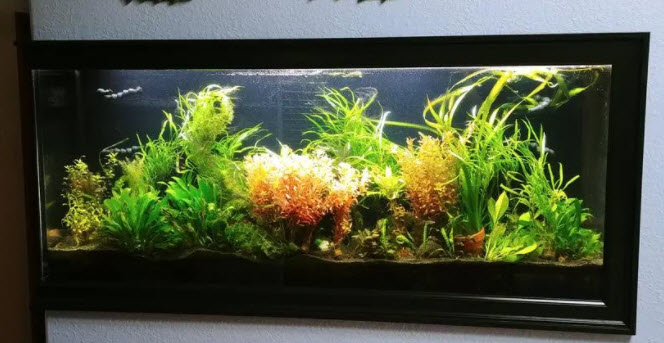
Aeration is creating a water/air interface in the aquarium where oxygen and carbon dioxide exchange can take place. Fish breath water. They need to get their oxygen from air dissolved into the water. So, this exchange is important.
For good aeration one needs to have chaotic turbulent flow of water at the interface with the air. Terms used to describe this turbulent flow are “surface agitation”, “choppy waves” or “breaking the surface tension”. Lots of bubbles rising through the water also give turbulent flow and excellent aeration (confirmed by testing and contrary to popular mythology) So good aeration can come from EITHER a lot of surface agitation or a lot of bubbles from a DECENT SIZED air pump and airstone combination.
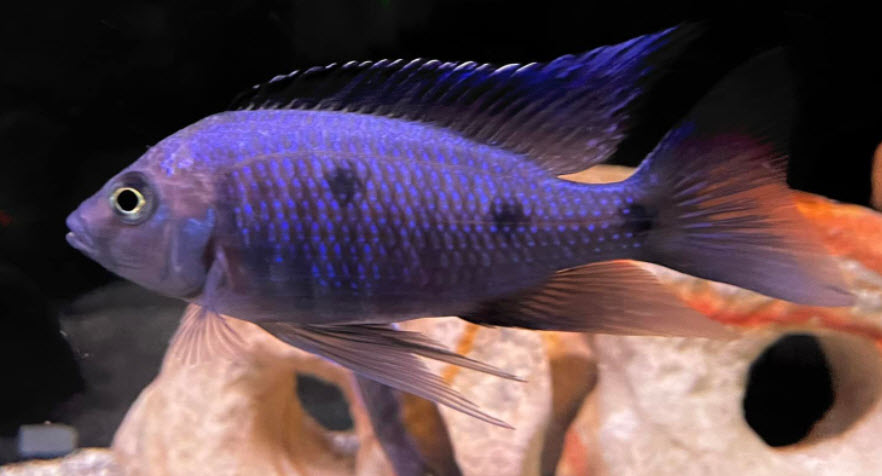
Signs of poor aeration in the fish depend on the currents in the aquarium:
- In a aquarium with little current, fish will hang motionless at the top of the water close to the surface with their gills rapidly moving. They will also “pipe”, taking in the water at the surface of the aquarium where the water has more oxygen dissolved in it.
- In a aquarium with a wavemaker and/or lots of current the fish will swim in the current with their mouths gaping, allowing the current to flow water rapidly over their gills.
There are several YouTube videos which claim aeration isn’t important. They claim that “osmosis” and “diffusion” with no surface agitation and no bubblers are quite sufficient for the fish. These well-meaning folks invariably have low tech planted aquariums with only a few fish. If their aquariums were even moderately stocked with fish, they would have a lot of dead fish. In any aquarium with decent amounts of fish, aeration is needed.
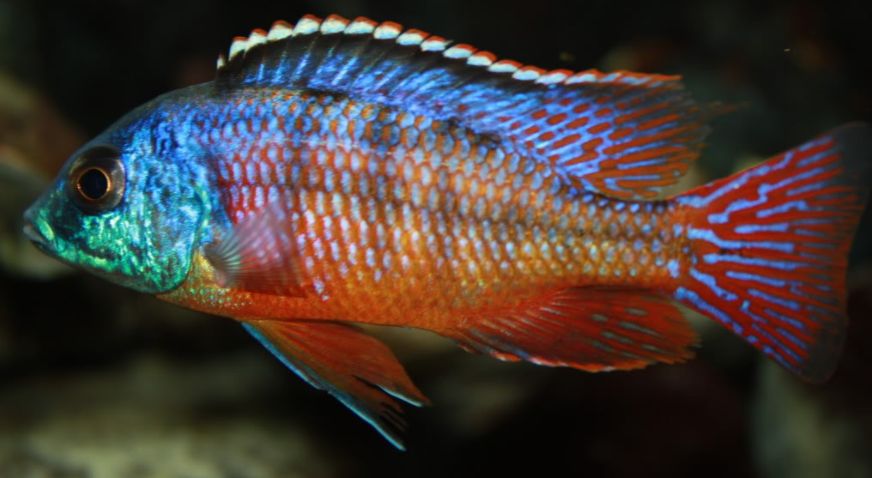
The Importance of “Turbulent Flow” to Aeration
One way to get good aeration is by having the surface of the aquarium be water which has rough turbulent “choppy” appearance to it. This can be the discharge from a filter outlet or the flow from an in-aquarium pump (a “wavemaker” or a “powerhead”). These are so-called “turbulent flow” areas which do an excellent job of aeration.
The concept is easy to see on the surface of the water:
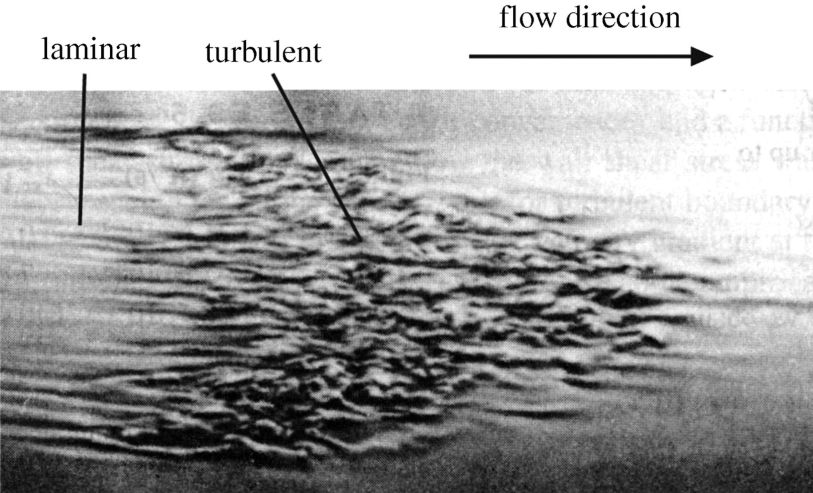
The laminar flow gives only slight aeration while the area of turbulent flow gives excellent aeration.
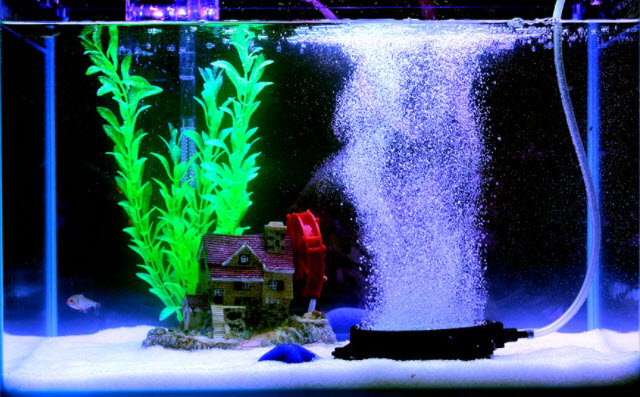
The other way to get excellent aeration is through the use of airstones. Note that airstones do an excellent job of aeration, AS LONG AS THE AIR PUMP IS LARGE ENOUGH TO PUT OUT HUNDREDS OF BUBBLES PER SECOND. The small air pumps sold for small amounts in some stores or over the internet or supplied with some aquariums in kits are insufficient to do much aeration.
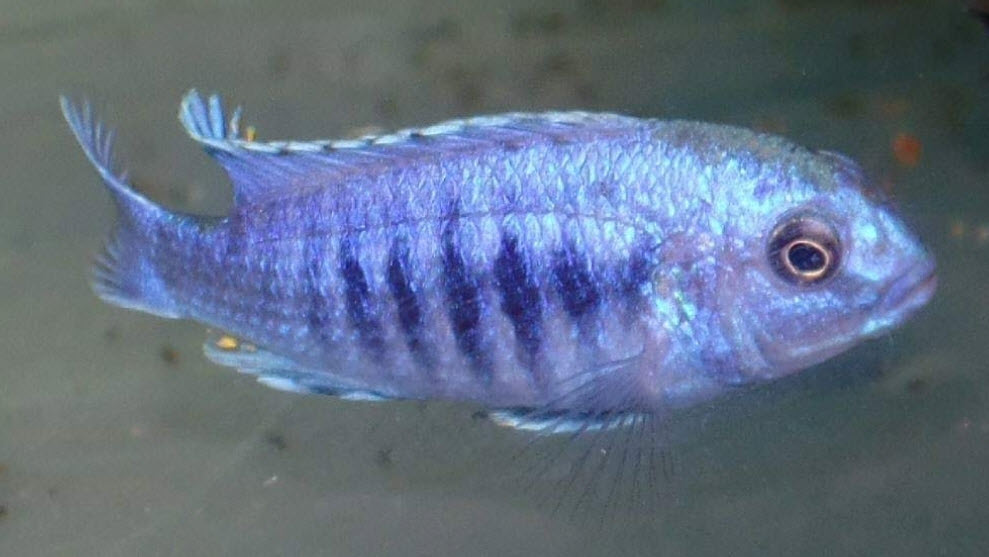
A table is instructive. Note that the variation from very good to very bad is huge when it comes to aeration, so an index of 100 is used. 100 is very good, 5 is very bad. The index is a VERY rough approximation of either the turbulent surface area or the calculated bubble surface area of each type of aeration. A ten inch by ten inch surface area turbulence will have a score of 100. Because of Brownian movement even a very still water surface will be doing some degree of exchange,
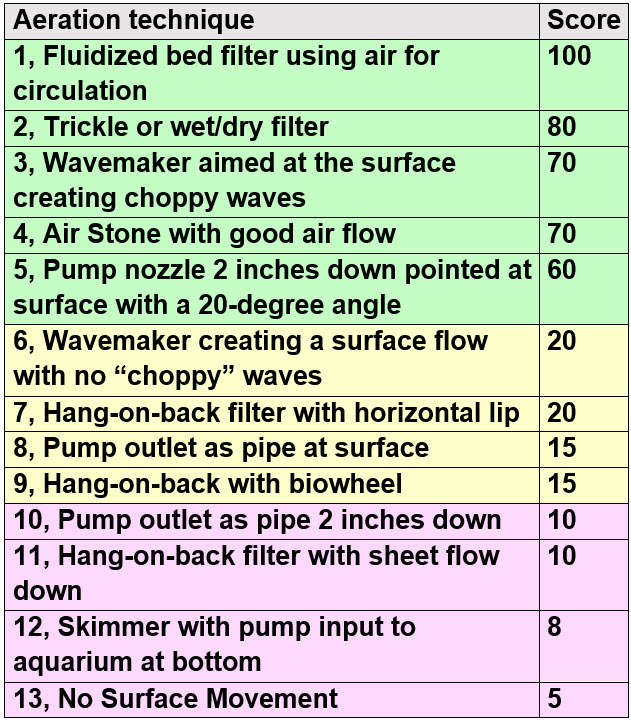
VERY ROUGHLY each 100 points that one has cumulatively on an aquarium can support a pound of fish. Now obviously each item will have large variations simply due to the size of each item. A five gallon wet/dry filter will have only one fifth the aeration capacity of a twenty five gallon wet dry filter.
Note that options 2 through 5 have turbulent flow water/air interfaces and have much higher ratings than the laminar flow of options 6 through 12.
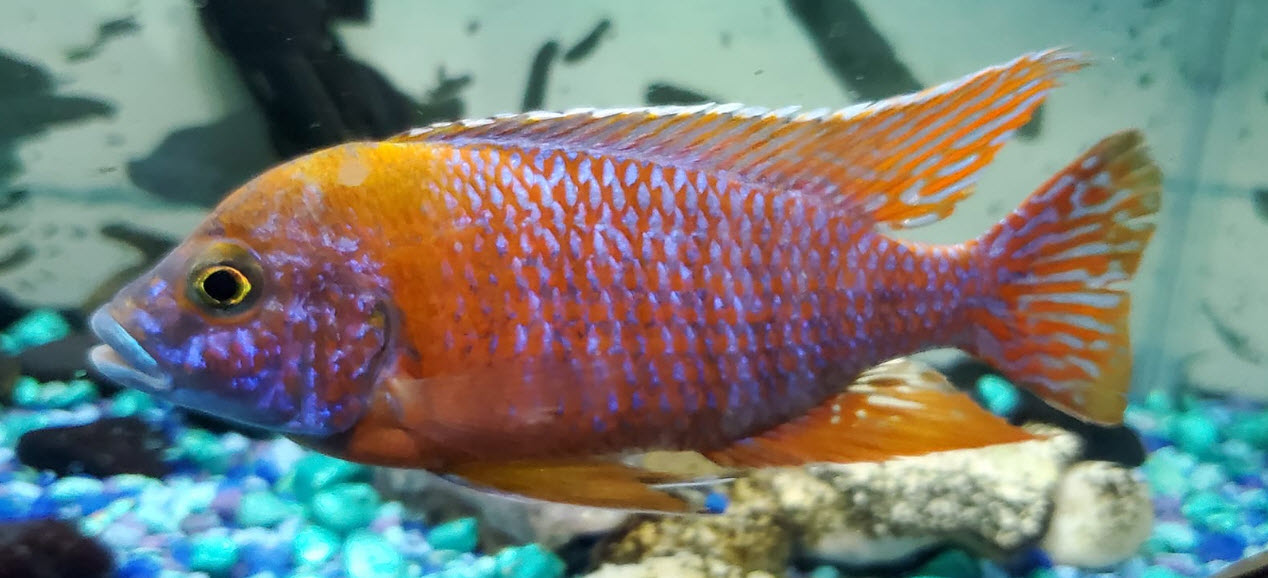
Aeration in a Dry Climate
Note that, in a dry climate, any option that includes an air pump and an air stone can pump a lot of dry air though the aquarium. When this dry air picks up the moisture from the aquarium it will carry it out of the aquarium. This can give a significant problem with evaporation. Obviously the drier the climate one is in the worse the problem will be. This will also be a problem with air pump operated K1 fluidized beds. In dry climates it is best to do the aeration with choppy waves, not air stones and air pumps.
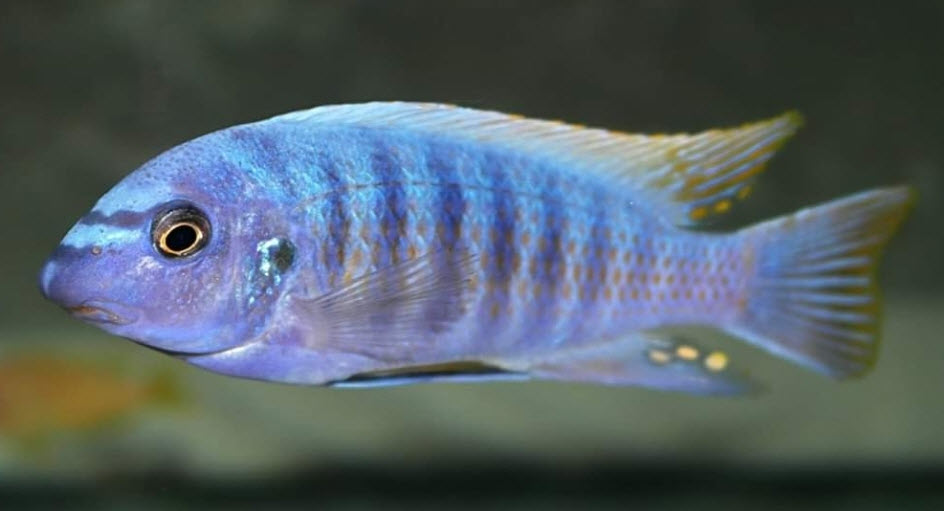
Why is Aeration Important
Aeration is important not only in that it directly helps a fish by letting it “breathe” easier, but also in that it indirectly helps the fish by cleaning up the water. Clean, bacteria free, crystal clear water is THE KEY to good fish health.
What happens is that all the living things in an aquarium need oxygen to oxidize organic compounds and produce energy in order to live. Thus bacteria and most other tiny organisms might reproduce twice as fast at an oxygen content of 8 ppm as they reproduce at an oxygen content of 7 ppm. So lets say some excess food releases dissolved organic compounds over a span of three days.
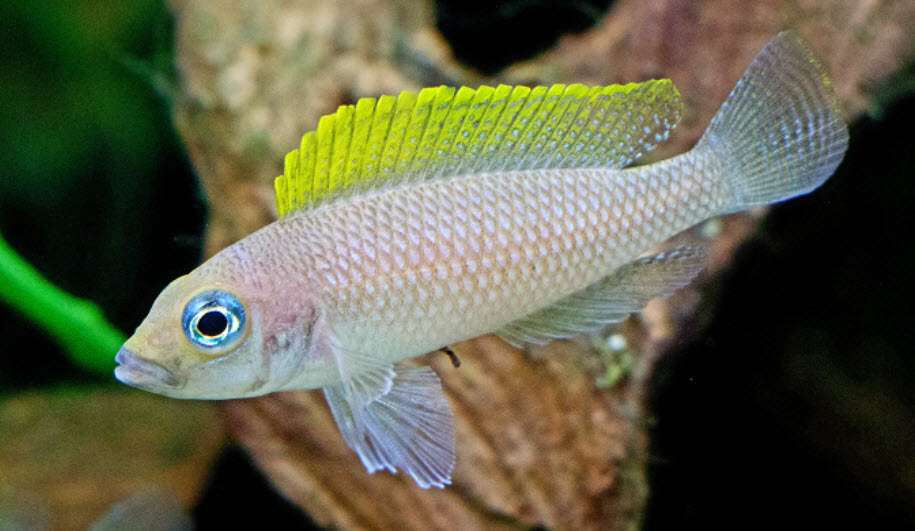
The dissolve organic compounds feed bacteria and the bacteria reproduce. Bacteria in the water column is bad for fish. But bacteria are also killed and eaten by many little creatures in an aquarium so they have finite lives. The faster the bacteria reproduce the faster they use up the dissolved organic compounds released by the food. So the bacteria stop reproducing at half the time at an oxygen content of 8 ppm as opposed to an oxygen content of 7 ppm. So there is half the bacteria in the water at 8 ppm than there is at 7 ppm.
This is of course just a huge generalization and there are literally hundreds of variables here. But it is clear that the more aeration one can get into an aquarium the healthier the fish will be.
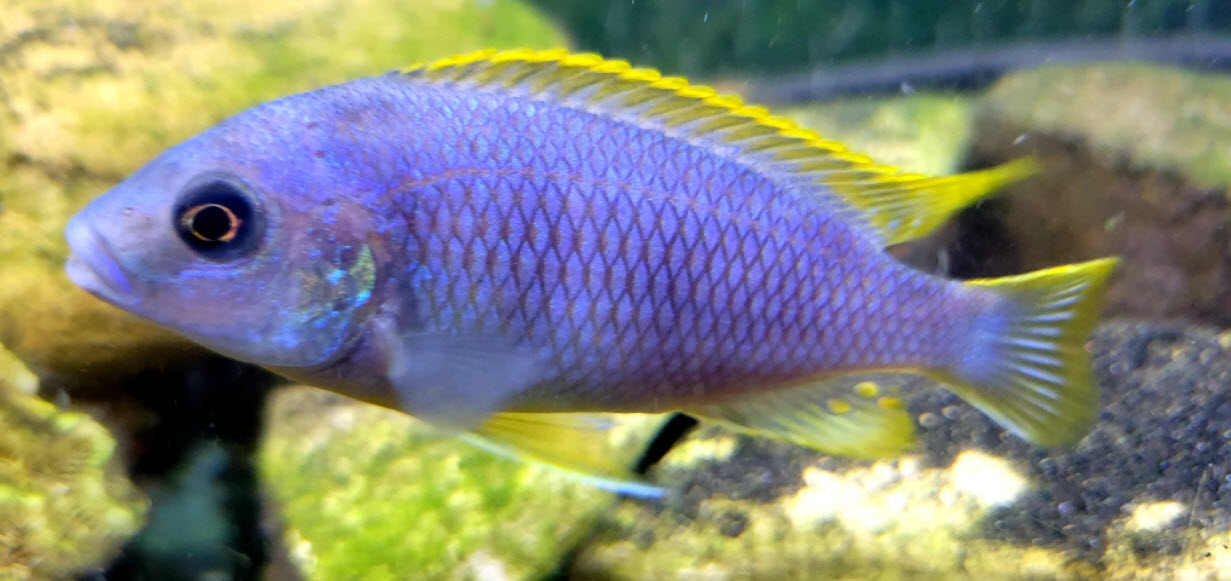
Aeration in More Depth
One note on aeration. Using aerosols and chemicals around an aquarium can kill a lot of fish. Jay Wilson lost a whole aquarium of fish when the floors were stripped in the room the aquarium was in. The air going into the aquarium needs to be pure air. Spraying for bugs can also create problems. Scents will not create a problem.
And if a house is tented one MUST remove the fish from the home prior to tenting. The gas used in tenting is very powerful and very penetrating and WILL kill any fish left in water in the home. This will happen even if the tank has the air pumps turned off and the tank is “sealed” with something like Saran wrap or aluminum foil.
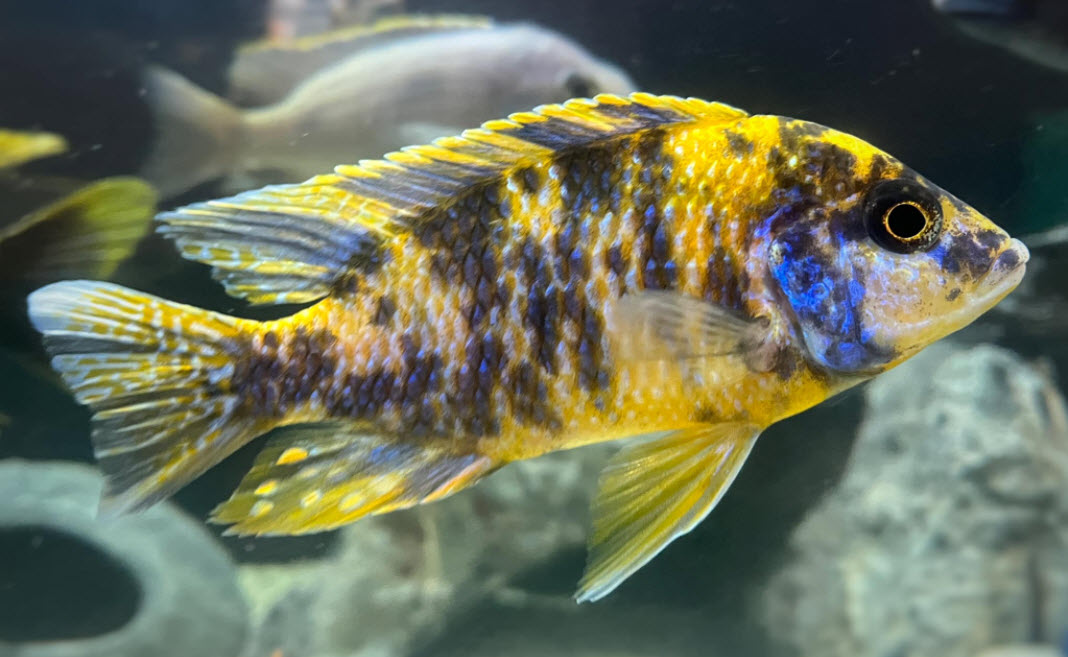
Surface Area and Aeration
There are some old myths about aeration generally bandied about on goldfish forums and pond forums. They are along the lines of 12 square inches of surface area in the aquarium are needed per inch of fish length. This is a common myth.
First off it ignores the fact that a two inch fish will NOT need twice the aeration of a one inch fish. Rather a two inch fish requires EIGHT TIMES the aeration of a one inch fish. Secondly it ignores the fact that a smooth as glass water surface will do about 5% of the aeration of a “choppy waves” surface of equal dimensions.
Another myth relates surface area to depth to find out if you have adequate aeration. The surface area to depth ratio is meaningless.
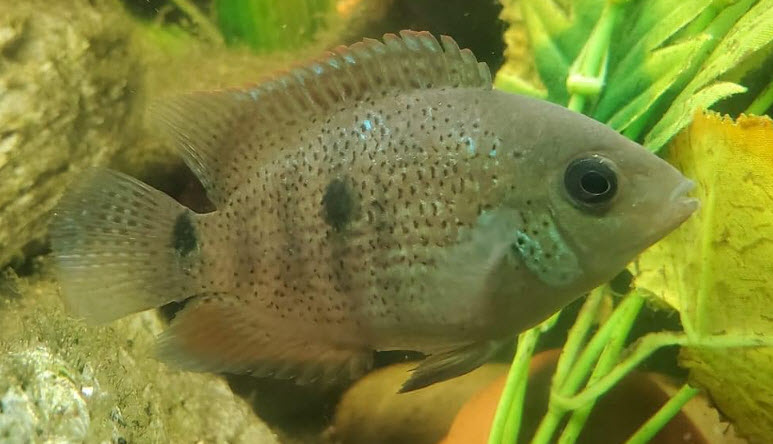
Units
If the water is FULLY saturated with air at 78 degrees F, it will be holding an oxygen level of 8.25 ppm (mg/L). Simply because the temperature is at 78 degrees the water will not necessarily be saturated. So the more aeration the better, irregardless of the temperature. Note that warm water holds less oxygen than cold water.
Aeration in Greater Depth
Aeration is discussed at greater length in the following links:
9.2. Aeration and Turbulence
9.3. Air Stones
9.4. Skimmers and Spray Bars
9.5. Aeration and Temperature
.
Return to Aeration Menu
.
Aquarium Science Website
The chapters shown below or on the right side in maroon lead to close to 400 articles on all aspects of keeping a freshwater aquarium. These articles have NO links to profit making sites and are thus unbiased in their recommendations, unlike all the for-profit sites you will find with Google. Bookmark and browse!
.

Frédéric Picher says
*6 -1 in the bathtub, then 5-2, in the aquarium. The 3 survivors thrive and they are beautiful. The also enjoy the food I cooked based on your recipe! Thank you!
Frédéric Picher says
I think we should add the night factor in a planted aquarium. I started a native aquarium with fish from the river L’assomption here in Québec province. It was late in the season to catch fish, but I managed to get 5 semotilus corporalis or fallfish (ouitouche in french). 6 was too much for a 50gal, according to their size, so I planned to release 2-3 of them. Waiting the end of cycling, I kept them in my bathtub, changing 90 % of water everyday with river water anddid’nt feed them (5 days). One died in the prcocess. He suffered in some ways of stress or else and kept hiding alone under driftwood. Expecting deaths, I planned to keep 3 of them and release the others, when it was time to put them in the aquarium. Then the river has frozen so fast that it would have been a real issue to get them back in nature. Everything went fine for four days. I had heavy filtration, even considering 5 fishes. I removed a filter which was there to boost cycling and check if everything went fine. I thought a possible lack of aeraition would manifest in hours at worse, so I went to bed. I was woken up by a noise and went to check the aquarium. They were all near dead or dead, pumping oxygen near the surface. I failed to reanimate one of them, 3 survived and the other was probably the noise i heard, i found it under furniture. I quickly made a 35% water change, suspecting a bug in the nitrogen cycle. They recovered well, and I thought I had fixed the problem. The day after, A1. And then came the night. The 3 remaining fishes began to surface, barely breathing. And then I understood. What could make the night fatal? Thing is: I also took Three huge eleocharis sp. from the wild. At least one pound each if you include the dirt within the roots. They are beautiful, higher than the aquarium, but when they wakened up in “spring conditions” with nitrates to eat and live dirt, they started to grow at high rated and sucked up oxygen as hell. When I realised this mistake, I removed one of them, still unsure if it was the cause. Then I thought : Let’s know. I turned on a bright zoomable spot and beamed the biggest eleocharis. In minutes, they began to act normally, except for one thing: They forced them throught the stems of the eleocharis, which are very rigid, almost lignified stems. They were feasting with oxygen, suddently loving and almost cuddling these life saver plants. I had never experienced this scenario and i swear i will never repeat. Still, I may be wrong.
Brad says
Thanks, Dave!
All built on the back of your copious website information and valuable advice!
Thanks as always for everything you do for the hobby. I feel I have learnt huge amounts, and that learning bears real results.
Dave says
In reply to Brad ….. That is turbulent aeration. As a result your water is crystal clear. It is exactly the right way to do it. Great aquarium!
Brad says
Hi Dave,
Interesting topic on Aeration.
I have made some adjustments to my aquarium. Do you feel this is more turbulent than laminar? (Link to a picture below). Obviously, I can only do so much in a 25-gallon aquarium.
https://www.sanechoice.cloud/wp-content/uploads/2024/01/oxygen-exchange-scaled.jpg
Thanks as always.
Brad
Dave says
In reply to Julie …. The stinky sponges can be reused. They will lose the smell in a few days. And the K1 is coated with a thin transparent coating of beneficial bacteria, so it is doing its job. I would wait a month or two on cleaning the second fluval. Other wise you won’t have a functioning filter and will have to do a fish in cycling.
Julie G says
Hi Dave-
I searched your site and didn’t find anything on stinky tank syndrome. We went away for a week and a Fluval FX6 jammed by a big snail 😤 in the 125 gal cichlid tank.
Fortunately, there is another Fluval FX6 in that tank, but the contents of the one that stopped smelled like a sewer! I replaced most of the foam with what I had available. I did clean out all the beautiful gunk in that filter as it just smelled horrible. Fish seemed ok, not pristine, and the tank needed a significant water change. Is it safe to re-use some of the stinky but cleaned sponges? I needed to get it functional again.
On a different tangent- the K1 I had used for the first time in that Fluval had essentially no gunk beneficial bacteria buildup on them. Should I see them coated with the brown mulm or good gunk? They like looked relatively clean while the sponges and filter material were gunked full (and stinky). In truth, it had been a solid 6-7 months since install and a heavily stocked tank.
I plan to do Fluval cleaning all this rainy DC weekend and your input will help. I used 2 baskets with K1 and 1 basket with pot scrubbers (following the Master’s suggestions). Thx as always!
Julie G
Dave says
In reply to Rahul ….. Increasing oxygenation drives CO2 levels to the range of 2 to 3 ppm. Plants do best at above 10 ppm CO2. So aeration will remove added CO2 such as will come from a soiled tank or a injected CO2 tank. Lots of plants with lots of moderate to large fish is challenging. Here is an article on it. https://aquariumscience.org/index.php/15-11-many-fish-many-plants/
Rahul says
The co2 section didn’t have a comment section, so posting it here..
I’m a bit confused now as essentially ANY method increasing oxygenation will decrease co2.
So what can be the method to keep a moderately/heavily stocked fishes in densely planted aquarium ( may be low tech or high tech plants)
Dave says
In reply to Tathagata …. I rewrote that section to read: “If the water is FULLY saturated with air at 78 degrees F, it will be holding an oxygen level of 8.25 ppm (mg/L). Simply because the temperature is at 78 degrees the water will not necessarily be saturated. So the more aeration the better, irregardless of the temperature.”
Tathagata says
Hi Dave,
“Water at 78 degrees F. will be 100% saturated with oxygen at a level of 8.25 mg/L” —- does this mean I won’t be needing additional aeration when my tank water temperature is 78 F ?
I’m from India and the tank temperature remains around 78 F for a major part of the year. That’s a good news then right ?